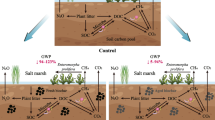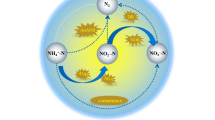Abstract
Sulfate adenylyltransferase gene and 4Fe–4S ferredoxin gene are the key genes related to sulfur and iron oxidations during bioleaching system, respectively. In order to better understand the bioleaching and microorganism synergistic mechanism in chalcopyrite bioleaching by mixed culture of moderate thermophiles, expressions of the two energy metabolism genes and community dynamics of free and attached microorganisms were investigated. Specific primers were designed for real-time quantitative PCR to study the expression of these genes. Real-time PCR results showed that sulfate adenylyltransferase gene was more highly expressed in Sulfobacillus thermosulfidooxidans than that in Acidithiobacillus caldus, and expression of 4Fe–4S ferredoxin gene was higher in Ferroplasma thermophilum than that in S. thermosulfidooxidans and Leptospirillum ferriphilum. The results indicated that in the bioleaching system of chalcopyrite concentrate, sulfur and iron oxidations were mainly performed by S. thermosulfidooxidans and F. thermophilum, respectively. The community dynamics results revealed that S. thermosulfidooxidans took up the largest proportion during the whole period, followed by F. thermophilum, A. caldus, and L. ferriphilum. The CCA analysis showed that 4Fe–4S ferredoxin gene expression was mainly affected (positively correlated) by high pH and elevated concentration of ferrous ion, while no factor was observed to prominently influence the expression of sulfate adenylyltransferase gene.





Similar content being viewed by others
References
Bick JA, Dennis JJ, Zylstra GJ, Nowack J (2000) Identification of a new class of 5′-adenysulfate (APS) reductase from sulfate-assimilating bacterial. J Bacteriol 182:135–142
Brierley JA, Brierley CL (2001) Present and future commercial applications of biohydrometallurgy. Hydrometallurgy 59:233–239
Cordoba EM, Munoz JA, Blazquez ML, Gonzalez F, Ballester A (2008) Leaching of chalcopyrite with ferric ion. Part IV: the role of redox potential in the presence of mesophilic and thermophilic bacteria. Hydrometallurgy 93:106–115
Ehrlich HL (2001) Past, present and future of biohydrometallurgy. Hydrometallurgy 59:127–134
Esparza M, Cardenas JP, Bowien B, Jedlicki E, Holmes DS (2010) Genes and pathways for CO2 fixation in the obligate, chemolithoautotrophic acidophile, Acidithiobacillus ferrooxidans, carbon fixation in A. ferrooxidans. BMC Microbiol 10:229
Fowler TA, Crundwell FK (1998) Leaching of zinc sulfide by Thiobacillus ferrooxidans: experiments with a controlled redox potential indicate no direct bacterial mechanism. Appl Environ Microbiol 64:3570–3575
Fu B, Zhou H, Zhang R, Qiu G (2008) Bioleaching of chalcopyrite by pure and mixed cultures of Acidithiobacillus spp. and Leptospirillum ferriphilum. Int Biodeterior Biodegrad 62:109–115
Gericke M, Govender Y, Pinches A (2010) Tank bioleaching of low-grade chalcopyrite concentrates using redox control. Hydrometallurgy 104:414–419
Gomes E, Ballester A, Blazquez M, Gonzalez F (1999) Silver-catalysed bioleaching of a chalcopyrite concentrate with mixed cultures of moderately thermophilic microorganisms. Hydrometallurgy 51:17–46
Gomes E, Ballester A, Gonzalez F, Blazquez M (1999) Leaching capacity of a new extremely thermophilic microorganism, Sulfolobus rivotinct. Hydrometallurgy 52:349–366
Guo X, Yin H, Liang Y, Hu Q, Zhou X, Xiao Y, Ma L, Zhang X, Qiu G, Liu X (2014) Comparative genome analysis reveals metabolic versatility and environmental adaptations of Sulfobacillus thermosulfidooxidans strain ST. PLoS One 9:1–10
Kinnunen PHM, Puhakka JA (2004) Characterization of iron- and sulphide mineral-oxidizing moderately thermophilic acidophilic bacteria from an Indonesian auto-heating copper mine waste heap and a deep South African gold mine. J Ind Microbiol Biot 31:409–414
Leustek T, Martin MN, Bick JA, Davies JP (2000) Pathways and regulation of sulfur metabolism revealed through molecular and genetic studies. Annu Rev Plant Phys 51:141–165
Li Q, Ren Y, Qiu G, Li N, Liu H, Dai Z, Fu X, Li S, Liang Y, Yin H, Liu X (2011) Insights into the pH up-shift responsive mechanism of Acidithiobacillus ferrooxidans by microarray transcriptome profiling. Folia Microbiol 56:439–451
Liu CQ, Plumb J, Hendry P (2006) Rapid specific detection and quantification of bacteria and archaea involved in mineral sulfide bioleaching using real-time PCR. Biotechnol Bioeng 94:330–336
Qian L, Zheng C, Liu J (2013) Characterization of iron-sulfur cluster assembly protein isca from Acidithiobacillus ferrooxidans. Biochemistry 78:244–251
Saito K (2004) Sulfur assimilatory metabolism. The long and smelling road. Plant Physiol 136:2443–2450
Sandstorm A, Peterson S (1997) Bioleaching of a complex sulphide ore with moderate thermophilic and extreme thermophilic microorganism. Hydrometallurgy 46:181–190
Vakylabad AB (2011) A comparison of bioleaching ability of mesophilic and moderately thermophilic culture on copper bioleaching from flotation concentrate and smelter dust. Int J Miner Process 101:94–99
Watling HR (2006) The bioleaching of sulphide minerals with emphasis on copper sulphides—a review. Hydrometallurgy 84:81–108
Wu C, Zeng W, Zhou H, Fu B, Huang J, Qiu G, Wang D (2007) Bioleaching of chalcopyrite by mixed culture of moderately thermophilic microorganisms. J Cent South Univ Technol 14:474–478
Yu R, Shi L, Gu G, Zhou D, You L, Chen M, Qiu G, Zeng W (2014) The shift of microbial community under the adjustment of initial and processing pH during bioleaching of chalcopyrite concentrate by moderate thermophiles. Bioresour Technol 162:300–307
Zeng J, Huang X, Liu Y, Liu J, Qiu G (2007) Expression, purification, and characterization of a [Fe2S2] cluster containing ferredoxin from Acidithiobacillus ferrooxidans. Curr Microbiol 55:518–523
Zeng W, Qiu G, Zhou H, Peng J, Chen M, Tan S, Chao W, Liu X, Zhang Y (2010) Community structure and dynamics of the free and attached microorganisms during moderately thermophilic bioleaching of chalcopyrite concentrate. Bioresour Technol 101:7068–7075
Zhang R, Wei M, Ji H, Chen X, Qiu G, Zhou H (2009) Application of real-time PCR to monitor population dynamics of defined mixed cultures of moderate thermophiles involved in bioleaching of chalcopyrite. Appl Microbiol Biotechnol 81:1161–1168
Zhou H, Liu X, Fu B, Qiu G, Huo Q, Zeng W, Liu J, Chen X (2007) Isolation and characterization of Acidithiobacillus caldus from several typical environments in China. J Cent South Univ Technol 14:163–169
Zhou H, Zhang R, Hu P, Zeng W, Xie Y, Wu C, Qiu G (2008) Isolation and characterization of Ferroplasma thermophilum sp nov, a novel extremely acidophilic, moderately thermophilic archaeon and its role in bioleaching of chalcopyrite. Appl Microbiol 105:591–601
Zhu J, Jiao W, Li Q, Liu X, Qin W, Qiu G, Hu Y, Chai L (2012) Investigation of energy gene expressions and community structures of free and attached acidophilic bacteria in chalcopyrite bioleaching. J Ind Microbiol Biotechnol 39:1833–1840
Acknowledgments
This work was supported by the China National Basic Research Program (No. 2010CB630903), the National Natural Science Foundation of China (Nos. 31200382, 31470230, 51320105006), China Postdoctoral Science Foundation (No. 2012M521562), the Planned Science and Technology Project of Hunan Province, China (No. 2013FJ4068) and Australia CSIRO OCE Science Leader Grant.
Author information
Authors and Affiliations
Corresponding author
Electronic supplementary material
Below is the link to the electronic supplementary material.
Rights and permissions
About this article
Cite this article
Zhou, D., Peng, T., Zhou, H. et al. Expression of Critical Sulfur- and Iron-Oxidation Genes and the Community Dynamics During Bioleaching of Chalcopyrite Concentrate by Moderate Thermophiles. Curr Microbiol 71, 62–69 (2015). https://doi.org/10.1007/s00284-015-0817-7
Received:
Accepted:
Published:
Issue Date:
DOI: https://doi.org/10.1007/s00284-015-0817-7




